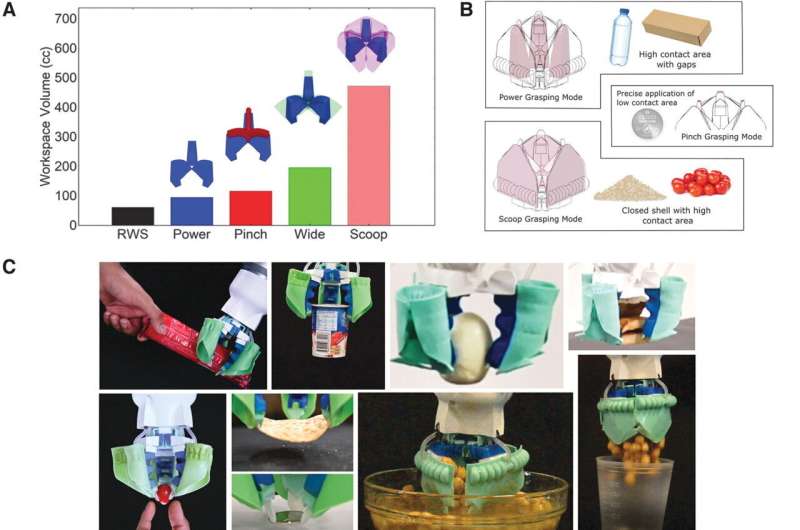(A) Plot showing the workspace volumes of the RWS gripper in its four modes. The gripper volume in the unactuated state (“RWS”) is also plotted for reference. (B) Illustration showing the variation of gripper contact area for various grasping modes, each contact area best suited for a payload type. (C) RWS Gripper grasping (top row, from left to right) a cookie pack (power grasping mode) yogurt container (wide grasping mode) egg and tofu stack (power grasping mode), (bottom row, from left to right), cherry tomato, crisp and coin (pinch grasping mode), and chickpeas (scoop grasping mode) (D) The RWS gripper grasping payloads from YCB benchmark object sets—(top row, from left to right) a mug, knife, tuna can, bolt, screw driver; (middle row, from left to right) scissors, can of spam, baseball, clamp, strawberry; (bottom row, from left to right) marker, screw driver, nut, credit card. Credit: SUTD
Researchers from the Singapore University of Technology and Design's (SUTD) Bio-Inspired Robotics and Design Laboratory have developed a new reconfigurable workspace soft (RWS) robotic gripper that can scoop, pick and grasp a wide range of consumer items. The RWS gripper's comprehensive and adaptive capabilities make it particularly useful in logistics and food industries where they depend on robotic automation to meet increasing demands in efficiently picking and packing items.
The RWS gripper can reliably scoop rice or couscous with radii as small as 1.5 millimeters or pick items as thin as 300 microns such as business cards or thin instruction manuals from flat surfaces. It can also grasp large convex, nonconvex, and deformable items such as melons, cereal boxes, or detergent refill bags which can weigh as much as 1.4kg.
Compared to traditional rigid grippers, soft grippers use compliant soft actuators and functional hyper elastic materials, allowing them to grasp a wider range of geometries safely and reliably. In addition, soft grippers' high degrees of freedom and compliance enable several grasp modes despite under actuation and oversimplified control strategies.
While being advantageous over their rigid counterparts, soft gripper capabilities such as contact effort are mostly a consequence of the gripper workspace, defined as the range of positions a robot can reach to interact with its physical environment. This, in turn, is largely constrained by the gripper design. Moreover, soft grippers designed for highly specific grasping tasks such as scooping grains or wide payloads are usually limited in grasping other payload types or in their manipulation versatility.
The RWS gripper overcomes limitations posed by previous grippers using a well packaged design of multimaterial soft actuators and passive compliant mechanisms to produce considerable reconfigurations in the gripper workspace volume without increasing the gripper volume or weight. Credit: SUTD
To overcome these limitations, the SUTD research team designed the RWS gripper using multimodal actuation, in which the grasping workspace of a soft gripper can be changed rapidly for payloads with different contact area requirements. Their research study titled 'A Multimodal, Reconfigurable Workspace Soft Gripper for Advanced Grasping Tasks' was published in Soft Robotics.
The RWS gripper can modify and increase its grasping workspace volume by 397% using a combination of shape morphing fingers, retractable nails and an expandable palm, enabling the widest range of grasping capabilities to date achieved by a single soft gripper.
The RWS gripper's ability to quickly reconfigure its grasping workspace makes it an ideal candidate for challenging applications for which multiple task-specific grippers would otherwise be required.
The SUTD research team is taking steps to commercialize the RWS grippers in various high-mix automation applications.
"We are in discussions with various logistics companies, both in the food and packaging sectors, to set up proof of value studies. The team is excited to create market impact and provide new solutions for our industry partners," shared Assistant Professor Pablo Valdivia y Alvarado, Principal Investigator and Team lead from SUTD.
More information: Snehal Jain et al, A Multimodal, Reconfigurable Workspace Soft Gripper for Advanced Grasping Tasks, Soft Robotics (2022). DOI: 10.1089/soro.2021.0225
Provided by Singapore University of Technology and Design
























